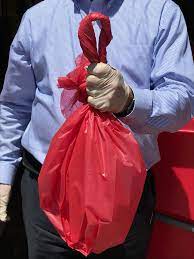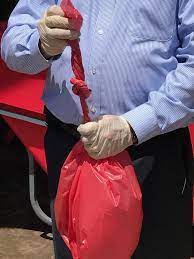REGULATED MEDICAL WASTE
The New York State Department of Environmental Conservation (NYSDEC) defines regulated medical waste (RMW) as waste that is generated in diagnosis, treatment or immunization of humans, or animals, in research pertaining thereto, or in production and testing of biologicals; provided, however, that regulated medical waste must not include hazardous waste and household medical waste.
RMW may also be known as biohazard waste, biological waste, infectious waste, red bag waste or wastes contaminated with "other potentially infectious material" (OPIM).
The NYSDEC has categorized RMW into the following types:
- Animal waste
- Cultures and stocks
- Human blood and blood products
- Human pathological wastes
- Sharps, used or unused (Please see the additional sharps page for more information pertaining to Daniels reusable sharps program on campus)
- Other waste materials containing infectious agents designated by the Commissioner of Health
RMW must be properly handled, collected, segregated, packaged, stored, labeled, transported and disposed of in order to minimize the risk of transmitting infection or endangering human health.
The following supplies are provided by Environmental Health & Safety:
- Red biohazard bags
- Regulated medical waste boxes
- Disposable sharps containers
- Reusable sharps containers (Daniels sharps) for the Health Science Center (HSC), MART and Life Science Complex

Image by David Pawlowski, Ph.D, RBP
Prior to the transportation of RMW to a collection area, ensure the following:
- Reusable sharps containers are locked at the front and side tabs
- Disposable sharps containers are locked and taped shut prior to being placed inside of an RMW box to prevent reopening
- Red Biohazard bags are tied properly prior to closure of the RMW box to prevent leaks in the event the box falls over or loose liquids reside in the box due to saturation of RMW inside of the bag as seen in the photos below



- RMW that may be saturated must be double bagged to prevent leakage
- RMW boxes are right side up, folded in pairs and taped as seen in the picture below Avoid setting up boxes upside down during storage within the lab and interlocking the flaps when closing the RMW box

- RMW boxes should also have the following information written on the top of the box in case of an emergency: P.I. (Principal Investigator), Building & Room Number
- RMW Boxes must not be more than 50 pounds and are free from leaks, bulges or tears
For disposal of RMW on campus, please refer to the collection schedule on the hazardous waste page. Contact hazwaste@stonybrook.edu for buildings that are serviced by request.1 1RMW in the MART and Health Science Center (HSC) are self-service.
- Regulated Medical Waste training is required for all persons generating RMW and those responsible for the transportation of RMW to a holding or collection area
- Signing a Regulated Medical Waste Manifest training is required within 90 days of assignment for all persons preparing RMW for transport and signing NYS Regulated Medical Waste Tracking Forms
- Use appropriate personal protective equipment such as nitrile gloves, lab coat and protective eyewear when handling or transferring infectious materials
- RMW must be placed in a red biohazard bag with the University's information printed in indelible ink (provided by EH&S)
- Garbage bags, black or clear, must not be used as a substitute for red biohazard bags
- Prior to transporting RMW, ensure it is packaged properly with the bottom and top
of the box folded in pairs and taped with packing tape for transportation
- Do not use scotch tape to tape your boxes
- Use a lab cart to transport RMW and use a freight elevator whenever possible, otherwise limit access to passenger elevators in the event the freight elevator is unavailable or the building doesn't have a designated freight elevator
- Support RMW boxes from the bottom of the box
- Never dispose of hazardous waste or municipal waste (garbage) in RMW boxes This includes, but is not limited to, batteries, chemical waste (solid, liquid or gaseous), compressed gas cylinders, electronics, food products or wrappers that are non-infectious, loose sharps, pharmaceuticals, radioactive waste that is not RMW and other types of wastes that are not regulated medical waste
- Never dispose of sharps in any non-sharps rated container, such as a biohazard bag, plastic or glass container or RMW box
How do I dispose of Ethidium Bromide gels if they can't be disposed of in RMW boxes?
EH&S supplies 5 gallon buckets for Ethidium Bromide gels. Please line the 5 gallon container with a plastic bag (not a red biohazard bag), if available. If not, EH&S can supply a plastic liner for the lab.
How do I dispose of serological, glass and other types of pipettes?
Contaminated serological pipettes and other contaminated pipettes that have any chance of puncturing an RMW red bag should be disposed of in sharps containers.
Where can I dispose of my RMW if my location is not listed on the website?
Contact hazwaste@stonybrook.edu for all waste requests. Someone with the hazwaste team will promptly respond to your request with a date and time for disposal.
If RMW (boxes and Daniels sharps containers) in the MART and HSC is self-service, where can I dispose of my RMW?
MART - Visit room 3M-0204 to store your RMW boxes for disposal. In this room you'll be able to swap out your full box for an empty box, additional red biohazard bags for disposal and empty Daniels sharps containers.
HSC - Visit room 1-200 "Regulated Medical Waste and Storage", in the hallway between the BST and HSC on the loading dock level, to store your RMW boxes for disposal. All RMW containers must be closed prior to transporting (all bags tied shut, cardboard boxes taped closed or red bins affixed with their lids). Reusable sharps containers can be found down the hallway from the RMW storage room nearest the BST freight elevator.If you have any additional questions not answered on this website, trainings or FAQ, please email hazwaste@stonybrook.edu your questions. Any frequently asked questions that pertain to labs and facilities on campus will be added to this FAQ.
All forms of Regulated Medical Waste (RMW) generated in University laboratories and other facilities must be disposed of in accordance to the guidelines and regulations mandated by the New York State Department of Environmental Conservation (NYSDEC) and other federal, state and local entities.
For more information about Stony Brook University's regulated medical waste management, please review the following policy:
